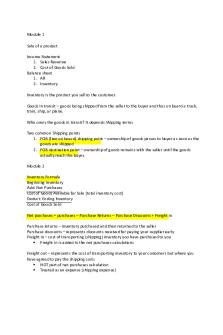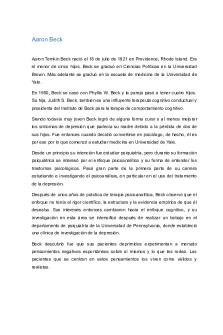Beck Depression Inventory Notes PDF

| Title | Beck Depression Inventory Notes |
|---|---|
| Course | Principles of Psychological Assessment |
| Institution | Athabasca University |
| Pages | 3 |
| File Size | 60.8 KB |
| File Type | |
| Total Downloads | 25 |
| Total Views | 138 |
Summary
Beck Depression Inventory notes...
Description
Background info Purpose of the test Method of construction Reliability Validity Limitations Strengths
Background Information Created by aaron T. Beck in 1961 Pioneer in Cognitive Therapy Interested in measuring depressive symptoms o He has inspired many in cognitive behaviour o President of the meritus o He is 94 Purpose of the BDI Measures the presence and severity of depressive symptoms Cognitive distortions that underlie depression Not meant to be a diagnostic tool Can be used as a first tier assessment tool Monitors changes Used in a wide variety of populations o It is a first tier assessment tool (maybe the first of many batteries of tests) o Originally just used for adult clinical populations o Now it’s used for adolescence, older people, the deaf population… o Been used on college students Method of Administration Beck is only 21 questions Was originally designed as an interview-restricted test Is now a self-report Both scales are up there: the first scale is used for those who are not currently depressed o 1-10 considered normal ups and downs o 11-16 mild mood disturbance o etc. o over 40 extreme depression on the second scale, even a score of 13= minimal depression BDI-II Sample Items 1-13 assess the psychological symptoms of depression Item 5 feelings of guilt 1 would be, I feel guilty part of the time 3 would be, I feel guilty all of the time
it’s pretty subjective for people to fill out Revisions BDI-IA, 1978: self-administration BDI-II, 1996: more cohesive to DSM-IV BDI-SF: Short Form for quick screen medical patients BDI-PC/BDI-FS: Primary Care/Fast Sheet for quick screen of medical inpatients Construction Questions asked to measure items including: feelings of guilt sadness pessimism past failure loss of pleasure punishment fears self-dislike New questions on BDI-II measure items include (more of a focus on the physical items of depression): agitation Reliability of the BDI High reliability Standardization Gender, race, ethnicity o One study found.. Test-retest (r = .93 to .59) o One study found… o A meta-analysis found… this indicates, the longer the time interval, the more variance it is, which isn’t necessarily a bad thing. It’s meant to track mood changes The longer the time interval, the less reliable Internal consistency (r = .84) o A meta-analysis found the internal consistency was high Restricting the range o The reliability scores, o This study suggested that it’s perhaps because of the range restriction Validity of the BDI Face Validity: appears valid Convergent Validity: relates well with other measures of depression Content Validity: BDI-II improved Construct Validity: relates high to other constructs found in depressed patients o Including stress, loneliness, anxiety, alcoholism, sleep patterns, and suicidal behaviours Factor Analysis: depressive symptoms divided into three parts
o Supports the validity of the BDI, because depression can be looked at as one syndrome divided into three parts which are, .. the body or somatic differences, etc.. Strengths Quick and painless Effective tool for assessment Can help confirm or deny depression Easy for professionals to assess their patients’ progress Cognitive items can track improvement o You can see an improvement with cognitive behavioural therapy o The goal of CBT is to help a person learn to recognize negative patterns of thought o If somebody is partaking in this therapy, and throughout they are taking the BDI, hopefully they will see improvements A great supplemental tool Limitations Individuals can minimize or exaggerate their responses Only an assessment tool, not a diagnostic one Minorities need to be represented in studies Physical symptoms could create false positives . even when the goal of the study was to examine ethnicities and minorities, mostly it was studying white people. . what about people with something like ALS?
Future Challenges Beck has created several other scales that measure including a measure for suicide, hopelessness, and anxiety More scales could be created to measure PTSD, bipolar disorder … etc....
Similar Free PDFs

Beck Depression Inventory Notes
- 3 Pages

Beck Anxiety Inventory
- 5 Pages

Major Depression - notes
- 1 Pages

Depression Theories - notes
- 2 Pages

Depression Ch - Lecture notes
- 61 Pages

Inventory Management Notes
- 60 Pages

Test Beck
- 2 Pages

Depression
- 1 Pages

Inventory Notes - Marc Smith
- 3 Pages

Notes ON Inventory Upload
- 40 Pages

Inventario beck
- 4 Pages

Aaron Beck
- 13 Pages
Popular Institutions
- Tinajero National High School - Annex
- Politeknik Caltex Riau
- Yokohama City University
- SGT University
- University of Al-Qadisiyah
- Divine Word College of Vigan
- Techniek College Rotterdam
- Universidade de Santiago
- Universiti Teknologi MARA Cawangan Johor Kampus Pasir Gudang
- Poltekkes Kemenkes Yogyakarta
- Baguio City National High School
- Colegio san marcos
- preparatoria uno
- Centro de Bachillerato Tecnológico Industrial y de Servicios No. 107
- Dalian Maritime University
- Quang Trung Secondary School
- Colegio Tecnológico en Informática
- Corporación Regional de Educación Superior
- Grupo CEDVA
- Dar Al Uloom University
- Centro de Estudios Preuniversitarios de la Universidad Nacional de Ingeniería
- 上智大学
- Aakash International School, Nuna Majara
- San Felipe Neri Catholic School
- Kang Chiao International School - New Taipei City
- Misamis Occidental National High School
- Institución Educativa Escuela Normal Juan Ladrilleros
- Kolehiyo ng Pantukan
- Batanes State College
- Instituto Continental
- Sekolah Menengah Kejuruan Kesehatan Kaltara (Tarakan)
- Colegio de La Inmaculada Concepcion - Cebu



